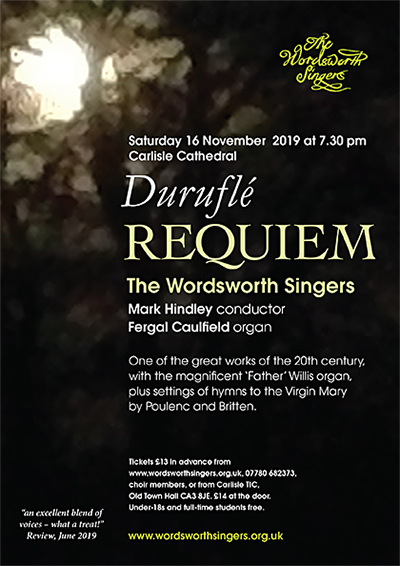
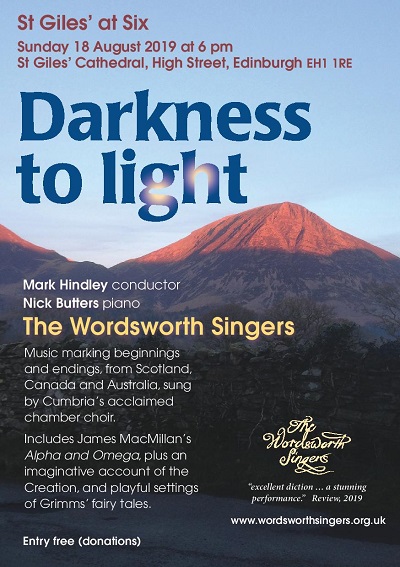
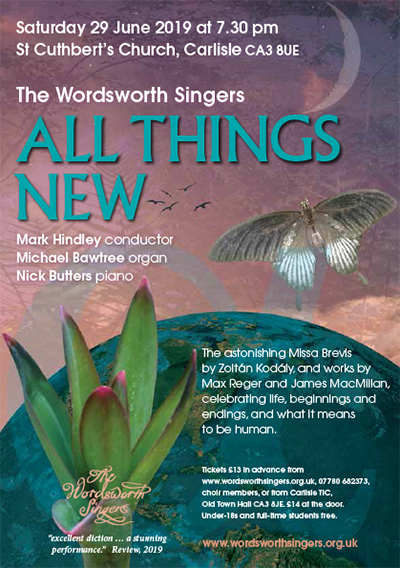
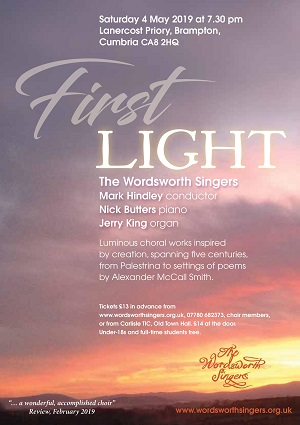
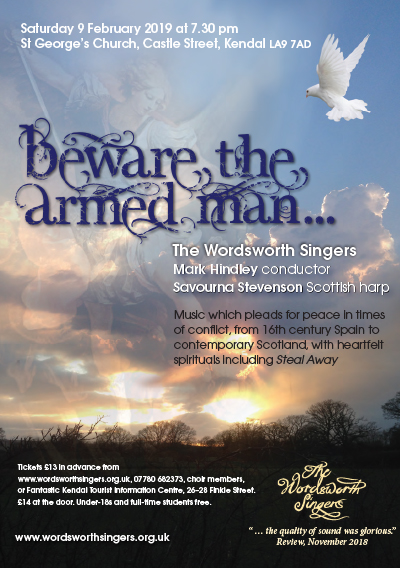
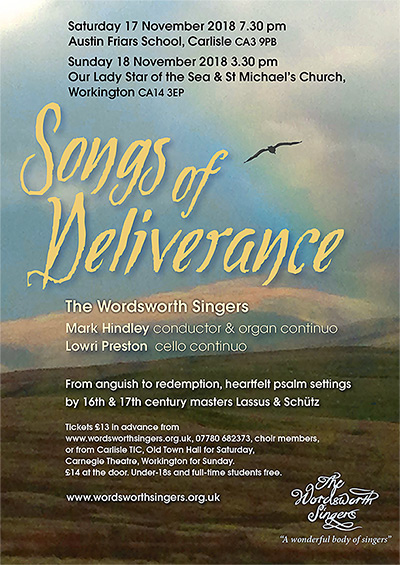
Guest Musicians
Nick Butters
Michael Bawtree
Jerry King
Savourna Stevenson
Lowri Preston
Fergal Caulfield
Duruflé Requiem

It is not hard, moving amongst the stone columns of a mediaeval English cathedral, to reimagine ancient plainchant sung so regularly in their midst over the preceding eight centuries. So the audience, gathered on Saturday in Carlisle’s lovely decorated gothic choir chancel, leading through to the Norman nave, were in a good place for what followed.
By losing most of their choral tradition after Napoleon, French church musicians had an unwelcome opportunity to reimagine their mediaeval musical past and portray it in their own musical language. Francois Poulenc’s “Litany to the Black Virgin” is a fervent reach back into the mystical past by an irreverent and witty twentieth century man, given pause by the numinous experience of visiting an ancient pilgrim church in a deep river gorge in Southern France. The women’s voices of The Wordsworth Singers gave Poulenc’s eccentric melodies a firm line, with admirable breath control and consistency of tone.
The men replied with two delicious but rarely heard pieces for men’s voices, the Ave Maria by Franz Biebl, and Nigra Sum by Pablo Casals. Each placed considerable demands of range and tone, obliging the twelve men present to resemble a full male voice choir. Assisted by the surprisingly comfortable acoustics of the cathedral, the men presented a charming blend, though they did not perhaps always manage to follow their conductor into the full sweeping emotional engagement to which he very capably invited them.
The piece all had come to hear was Maurice Durufle’s Requiem. Founded on that mediaeval Gregorian chant, the work is given an individual magic with an exquisite interlacing of the most luxurious organ accompaniment. Here another of the cathedral’s assets, its magnificent beast of an organ, came into full focus. In fact, the audience sat facing into the choir with their backs to the East End, so as to behold the full force of the organ’s magnificent range of sounds.
The choir is well suited to this piece, which requires an essentially prayerful tone, the softs many, the louds warm and fervent, rather than angry or aggressive. The occasional exceptions to this, where the composer urges the choir to ‘let rip’, imploring the King of Glory to deliver us from the lion’s mouth so that Hell does not swallow us up, or imitating the heavenly hosts crying Hosanna in the highest were perhaps a little underpowered. But the complexity of the piece is in the constant variations of dynamics and pace, and the choir’s conductor Mark Hindley maintained a masterful grasp of the line and sweep. Here was a performance of dramatic integrity.
A highlight in the centre of the Requiem is the little movement, “Pie Jesu” (Gracious Jesus, grant them eternal rest), given in Durufle’s score (as in Faure’s) to a soprano soloist. It is a high wire act, taking the singer both from the very depths of her range to the top and also from the tiniest pianissimo to the fullest forte. Fiona Weakley delivered all this, filling the entire cathedral with emotionally charged singing of high quality.
The first and last notes of the evening were created on the cathedral’s organ by the renowned Irish organist Fergal Caulfield. His virtuosity and imaginative selection of registrations showed off Carlisle’s great instrument to its full, particularly in a thrillingly fast and furious rendition of Olivier Messiaen’s toccata, ‘Transports de joie’. Equally remarkable though were the sheer range of timbres and voices he found, not only to punctuate the ebb and flow of the Requiem, but also in a highly enjoyable Spanish ‘tiento’ or fantasia by Francisco Correa de Arauxo. For that short moment the audience was transported to seventeenth century Seville, before an a capella return to England with Benjamin Britten’s motet for choir and solo quartet Hymn To The Virgin. This apparently simple piece will often defeat amateur choirs, unaware of the unforgiving way bad tuning, ensemble or pacing will immediately show. The Wordsworth Singers, under Mark Hindley’s magisterial guidance, demonstrated that they are a choir of high standards by turning in a polished performance that left the audience momentarily silent, following the dying of the final quiet notes into the far corners of the cathedral.
Paul im Thurn
Darkness to Light

St Giles’ Cathedral, Edinburgh
No review available.
All Things New

What a treat! To hear The Wordsworth Singers perform a concert of works by Kodály, Reger, MacMillan and Bevan in the elegant surroundings of St. Cuthbert’s Church, Carlisle, was sheer pleasure. Entitled “All Things New”, this interesting and challenging mixture of compositions was conducted by Mark Hindley, with accompaniments provided by Michael Bawtree (organ) and Nick Butters (piano).
Zoltan Kodály’s Missa Brevis filled the first half, with its eight sections, accompanied with greatly varied registrations and musicality by Michael Bawtree, playing the large but electro-mechanically temperamental organ of St. Cuthbert’s. There was an excellent blend of voices and organ accompaniment throughout the varied sections, ranging from very dark and foreboding sonorities in the opening Introit and Kyrie (this work was written as World War II raged outside the composer’s refuge) to the serenely gentle and beautiful Sanctus and Benedictus. The work ended with a very forceful organ solo, climaxing with the sounds of the very loud Tromba.
The second half started with Max Reger’s 8 Geistliche Gesänge. These are a very varied, richly chromatic and atmospheric set of songs, written at the beginning of World War I. Mostly mildly discordant, they range from the confident to the mysteriously peaceful. There was plenty of bright, clear singing in the climaxes, as well as gently flowing choral sounds in the quieter passages.
Kodaly’s ‘Este’ is an evocation of the tranquillity of the late evening, beautifully captured by the choir, making use of exotic harmonies and with a solo soprano floating exquisitely above the choral textures.
After this, Nick Butters played ‘New Roads, Old Destinations’ by Australian composer Stuart Greenbaum, an expertly crafted and performed piano solo, an audio illusion with interesting twists and turns along the way.
James MacMillan’s ‘Alpha and Omega’, with words based on a passage from the Book of Revelation, opens with strident chords, suddenly changing to a more fluid and slightly syncopated section, which then builds to a fine climax. There were a couple of moments of uncertainty in tuning here, however Mark expertly restored equilibrium.
Finally, we heard Allan Bevan’s ‘Singers to Come’. After an introduction on the piano, the music intensifies noticeably, although, overall, it is a soothing work, building to several climaxes, all sustained expertly by Nick’s excellent accompaniment, which matched the ebb and flow of the music perfectly. Overall, this was an evening of fine musical performances in eminently beautiful surroundings.
Mike Town

Lanercost Priory, 4 May
No review available.
Beware the Armed Man…

The Wordsworth Singers came to town and proved to be a wonderful choir under their conductor Mark Hindley.
They presented a challenging and innovative programme of works pleading for peace. Two of the works were set against a background of the growing threat from Nazism: the Five Spirituals by Tippett, and Poulenc’s Un soir de neige. There was also a new work by Savourna Stevenson about St Magnus, the patron saint of Orkney and his refusal to take part in violence, and the Missa L’homme armé by Morales. A programme containing powerful lyrics and evocative imagery of peace in times of conflict
The performance of the Morales Mass had beautiful shaped lines. The choir’s great sense of the interplay of parts, such as in the Sanctus, was wonderful. There were times when there was an imbalance between the parts but a stunning performance nevertheless.
Being a small choir, performing the Negro Spirituals allowed them to present a performance of immense clarity and flexibility. This was as evident in the softer lyrical movements such as Deep River, as in the fierier rhythmic movements such as Nobody Knows.
The cold church provided a wonderful backdrop for the desolate bleak snowy landscape of Poulenc’s Un soir de neige. This highly chromatic work showed off the choir’s ability to perform such a challenging work but I wasn’t sure whether, at times, they captured the sense of the wintery journey of despair and the snowy landscape.
Another aspect of this accomplished choir is their excellent diction which was captured in their telling the story of St Magnus in this English premiere of Magnus by Savourna Stevenson
Please come back to Kendal and bring with you Savourna Stevenson who performed two stunning pieces on the Scottish folk harp. The different timbres she created such as those from South America in Mexican Monterey, and the speed of changing keys using the levers, was dazzling.
Philip Burton
Songs of Deliverance

The acoustically vibrant chapel at Austin Friars School was the perfect setting for a Renaissance musical masterclass on a dark November evening. And who better to deliver this masterclass than The Wordsworth Singers, a choir of significant prestige who have rightly garnered praise and an eager following throughout Cumbria and the North of England? ‘Songs of Deliverance’ explored settings of the Psalms in Latin and German, by two of the foremost Renaissance composers, Schütz and Lassus. All but one of Schütz’s motets here were set for two choirs competing and complementing from balconies on opposing sides of a cathedral. The intimate setting within this chapel precluded this logistical feat, and although there was an element of separation allowing the audience the sense of this, the overall effect was nonetheless stunning. These were dense textures where up to eight parts could be competing for your attention, but the balance was perfect, and never overwhelming. Cellist Lowri Preston’s sensitively played continuo added just the right amount of warmth without upsetting the balance. The acoustics no doubt played their part but had to be managed too, and the balance between lines, dynamic range, tuning and above all the sense of enjoyment from each member of the choir was second to none. Just as the quality of sound was glorious, so too was the use of space between sections and movements that allowed the sound to play out without breaking the spell. At times percussive and declamatory, this was also a sensual dark chocolate melt-in-the-mouth performance! The two Lassus works were no less complex in texture but the clarity of tone blended with the energy and placement in the delivery allowed the words to shine through. This was a brave programme of rich textures that the Wordsworth Singers delivered with full commitment, and praise must be due to their Director, Mark Hindley who not only devised the programme but coaxed and cajoled them from behind the organ continuo, giving them the space and time to really enjoy and express this fabulous music. This was no more evident than in the final piece, ‘Selig Sind die Toten’ (Blessed are the Dead) by Schütz with its modern harmonic shifts and dissonant suspensions that almost hung in the air, a beautiful and moving conclusion to another first class concert by The Wordsworth Singers.
Jerry King
‘Songs of Deliverance’ was performed at Austin Friars School Chapel on Saturday 17th November 2018, and repeated at Our Lady, Star of the Sea & St Michael’s Church, Workington the following day.
